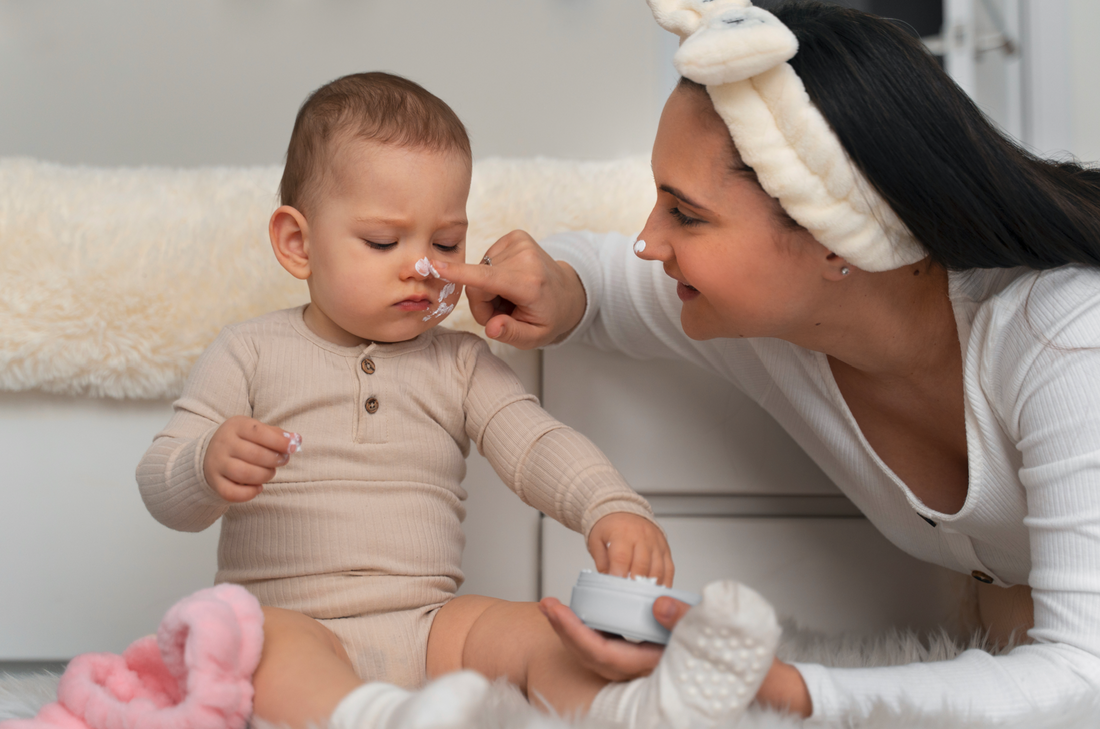
How to Read Baby Product Labels Without Losing Your Mind
Have you ever stood in the baby aisle, picked up a lotion or diaper pack, and felt like you suddenly needed a chemistry degree?
The front says: “100% Natural • Hypoallergenic • Eco-Blend.”
Sounds safe, right? But then you flip it over and see an ingredient list that looks like it belongs in a science textbook. Methylparaben? Cocamidopropyl betaine? Parfum?
And suddenly that quick shopping trip feels overwhelming. You’re stuck wondering, “Is this safe for my baby? What do these words even mean? Why does everything sound so good but feel so suspicious?”
If you’ve been there, you’re not alone. Almost every parent has had this “label panic moment.” And the truth is, it’s not your fault. Labels are written to sound comforting, not necessarily to be clear.
What Do Labels Really Mean? (The Tricks They Play)
Brands know the words that instantly calm parents: natural, gentle, eco-friendly, non-toxic, sustainable, biodegradable.
They sound reassuring, but most of them don’t have strict definitions.
· “Natural” might mean one drop of aloe mixed with a dozen synthetic chemicals.
· “Eco-friendly” could apply only to the cardboard box, not the lotion inside.
· “Biodegradable”? That might only work in an industrial composting facility, not in your dustbin.
Golden rule: the front label is advertising; the back label is the truth.
Which Ingredients Should I Avoid? (The Hidden Nasties on the Back)
The problem isn’t just the vague words on the front. It’s the ingredients most of us can’t even pronounce. Here are some common ones to watch for:
· Parabens: Preservatives in lotions and creams that are linked to hormone disruption.
· Phthalates: Often tucked away under “fragrance” and connected to developmental concerns.
· 1,4-Dioxane: A toxic by-product that never shows up on labels but has been found in baby shampoos.
· Formaldehyde releasers: Preservatives that can irritate delicate skin.
· PFAS (the “forever chemicals”): Used in waterproof finishes on fabrics and known to build up in the body.
For babies, whose skin is thinner, and bodies more sensitive, even small amounts matter. That’s why it’s so important to know what to look for.
Which Certifications Can I Trust? (The Good Guys You Can Trust)
Not all logos are fake reassurance. Some seals actually mean a product has been properly tested and meets strict safety standards. Look out for these:
· GOTS (Global Organic Textile Standard): Ensures organic fibres and bans harmful chemicals in baby clothes and bedding.
· OEKO-TEX: Tests fabrics (even zippers and buttons) for harmful substances.
· Made Safe®: Screens baby lotions and care products against hundreds of risky chemicals.
· ECOCERT: A trusted name in organic cosmetics and textiles.
· BIS/ISI (India): The mandatory safety standard for toys, bottles, diapers and more.
When you see these, you can trust them far more than the comforting words on the front of the pack.
A Simple Hack for Parents for Safer Shopping
Next time you shop, use this quick checklist:
- Flip the pack. The front is fluff, the back is facts.
- Check for credible seals like GOTS, OEKO-TEX, Made Safe, ECOCERT or BIS.
- Read the ingredient list. Shorter and simpler is usually better.
- Look at percentages. “Contains organic cotton” is not the same as “100% organic cotton.”
- Notice the packaging. Recyclable cardboard beats layers of plastic any day.
Final Word
So, the next time you’re holding a baby lotion or swaddle pack and second-guessing whether it’s safe, remember this: flip it, check it, question it.
Because parenting is already overwhelming. Reading labels shouldn’t be. 🌿💚
If you’re looking for daily encouragement, gentle parenting tips, and real conversations about sleep and safety, join our Parenting Community on WhatsApp: Parenting Village
References & Sources
This blog is based on credible research and regulatory guidance:
· FDA guidance on the use of “natural” in labeling (FDA)
· Environmental Working Group — Toxic chemicals found in kids’ bath products (EWG)
· Healthline — Baby skin care ingredients to avoid (Healthline)
· Women’s Voices for the Earth — Chemicals in baby products (WVE)
· Global Organic Textile Standard (GOTS) (GOTS)
· OEKO-TEX certification details (OEKO-TEX)
· Made Safe® certification (Made Safe)
· ECOCERT certification (ECOCERT)
· Bureau of Indian Standards — ISI mark and product regulations (BIS)
